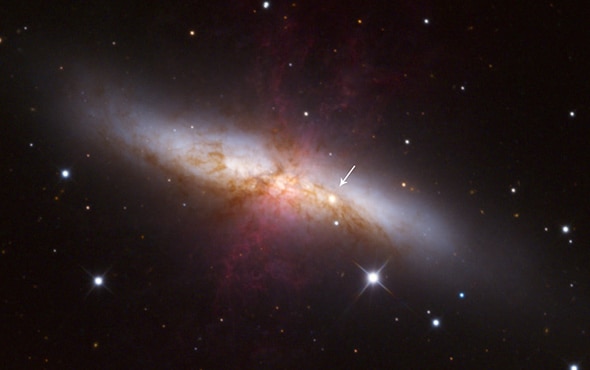Create a free profile to get unlimited access to exclusive videos, sweepstakes, and more!
The Curious Incident of the Supernova in the Nighttime

Detective Gregory: “Is there any other point to which you would wish to draw my attention?”
Holmes: “To the curious incident of the dog in the night-time.”
Gregory: “The dog did nothing in the night-time.”
Holmes: “That was the curious incident.”
— “Silver Blaze,” by Arthur Conan Doyle
Sometimes, you learn more about something when it isn’t there.
In January 2014, the light from a distant supernova reached Earth. It caused some excitement because the star that exploded was in the nearby galaxy M82 and that meant it was within reach of even small telescopes—in fact, it was discovered using an amateur-sized 35 cm telescope being used by an undergraduate astronomy class. Using my own telescope, I saw this supernova at the eyepiece as well.
Even better, the supernova, called SN 2014J (the 10th one discovered in 2014), was a special one: Type Ia, the kind used to measure the expansion of the Universe. We can see them very far away, and they’re used as benchmarks to calibrate distances to extremely remote galaxies. Seeing one nearby allows us to better understand them, and therefore better understand the size and expansion of the Universe itself.
Because the supernova was in a nearby, well-studied galaxy, we have lots of observations of the area before and after the explosion. The mighty orbiting Chandra X-Ray Observatory was pointed at M82 after the supernova went off, and found something surprising: nothing.
The image shows the galaxy in X-rays—extremely high-energy light emitted by black holes, very hot gas, stars being born, and, sometimes, supernovae. The little box marks the location of the star, and inset are enlargements; on the left is centered on the region before the star blew up, and on the right is the same area after the supernova. As you can see, there’s nothing there.
That’s interesting! We know that this type of explosion is caused by a white dwarf, the extremely dense core of a star that was once much like the Sun but has since shed its outer layers (much like the Sun will do in about 6 billion years after it becomes a red giant). There are several ideas about what happens next. It’s possible the white dwarf siphons material off a nearby companion star; that stuff piles up, gets very hot, and then fuses like a gigantic nuclear bomb, shredding the star and creating a very large bang indeed.
Another model is that two white dwarfs circle each other and, over billions of years, eventually merge. They collapse into an even-denser neutron star, and again you get a very large explosion. There’s even a third idea that there are three stars involved, two white dwarfs and a “normal” star, and the interaction between them causes a direct, head-on collision between the two dwarfs, causing the explosion. All three ideas have their merits, and astronomers are still arguing over them.
What makes SN 2014J critical to this is that if it were a white dwarf sucking material off a binary companion star, we’d expect some of that gas to get flung out into space; white dwarfs, apparently, are sloppy eaters. But when the dwarf explodes, the blast wave would slam into that material, and the interaction should generate copious X-rays. Yet none is seen.
And that’s why this is so interesting. It would appear the normal star binary companion model doesn’t work for 2014J … at least, without some other event going on, like perhaps a whole bunch of smaller pre-supernova eruptions that cleared the region of gas. That’s possible, but I prefer not to have to resort to special circumstances when other explanations are also likely.
The next step is to continue taking more observations. The debris from the explosion is still screaming outward, and will continue to do so for years. As it expands, any gas out there will get plowed, and Chandra should see it. Until then, though, we must be much like Sherlock Holmes, looking at the evidence that isn’t there as well as that which is.


























